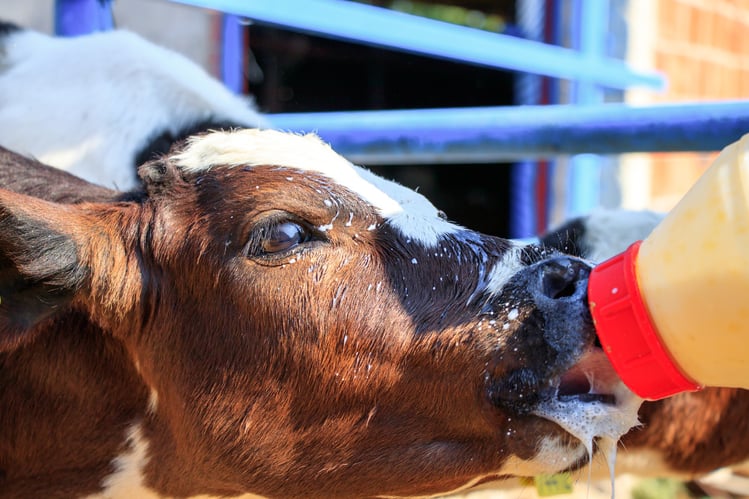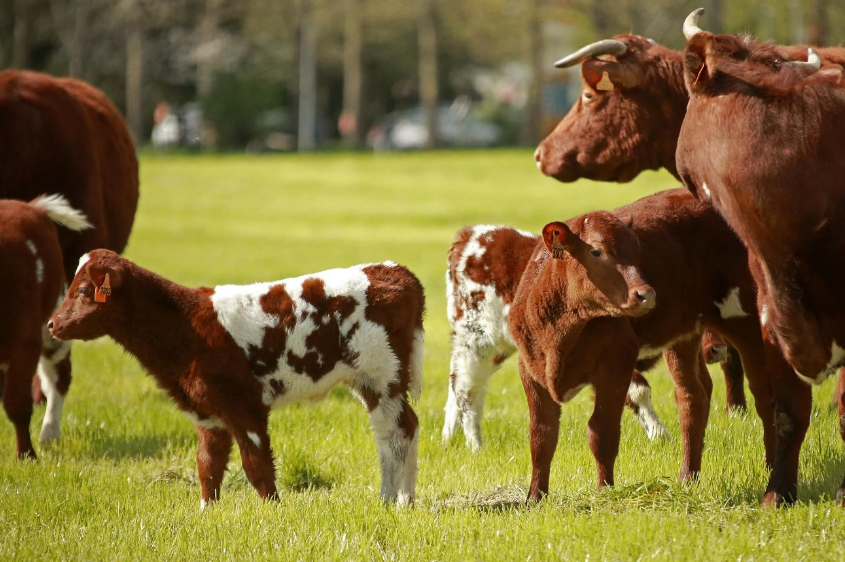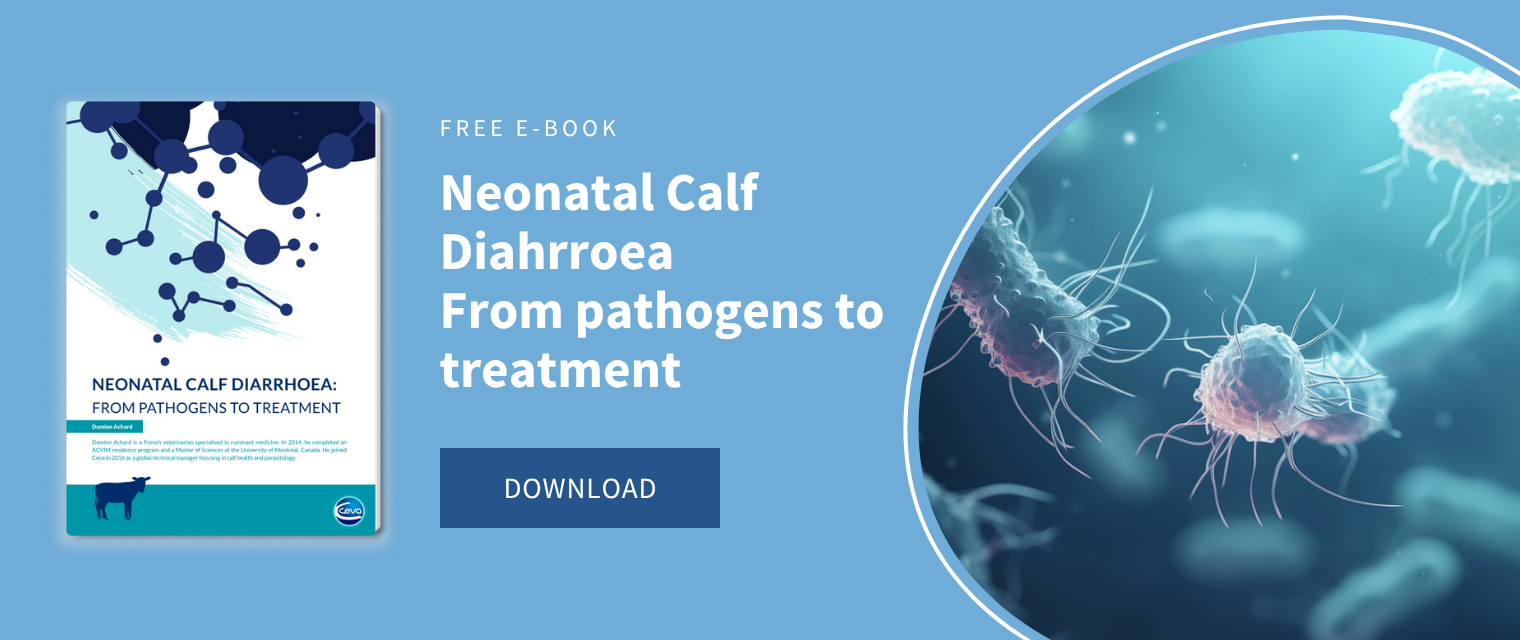Cryptosporidiosis in calves is typically observed in young animals of less than one month of age. This endemic disease is essentially caused by Cryptosporidium parvum (C. parvum), a protozoan parasite responsible for gastrointestinal illness and known to impair the growth of affected calves over an extended period.
Prefer to listen to this article? Click the play button below and enjoy our podcast!

Clinical picture
The disease is clinically characterized by a watery, profuse diarrhea. The diarrhea, which is pale yellow with mucus, can last for up to two weeks. Faeces may occasionally contain strands of blood but in general the diarrhea is not haemorrhagic. Calves are usually lethargic, anorexic and dehydrated but diarrhea can be the only clinical sign present. In some cases, fever may be present. In severe cases, calves can die from dehydration and cardiovascular collapse. Dehydration associated with electrolyte and acid-base imbalances are responsible for metabolic acidosis which is typically observed in calves with cryptosporidiosis even when calves ‘general condition and suckling reflexes are good [1]. This stressed out the importance to address rehydration in the treatment plan of calves affected by cryptosporidiosis.

© Keidel and Daugschies, 2013
Rehydration for calves with cryptosporidiosis
Because the most common causes of death in diarrheic calves are dehydration and acidosis whatever the causative agent, the immediate treatment objective should be focused on correcting dehydration, increasing blood pH to correct the acidemia, restoring electrolyte concentrations while providing nutritional support [2].
In many situations oral electrolyte solutions (OES) are indicated for resuscitating diarrheic calves with moderate dehydration and acidemia while subcutaneous fluid administration has been shown to be slow to increase plasma volume or blood pH and likely represents a poor option in calves for treating diarrhea [3]. OES formulations can be mixed with fresh cow's milk, milk replacer or water. They typically contain electrolytes (sodium, chloride, potassium), alkalinizing agents (bicarbonate or its precursor such as acetate, citrate, and propionate or formate, a metabolizable strong anion), components that facilitate sodium absorption (glucose, glycine, acetate, propionate), and substrates that provide additional energy (glucose, acetate, propionate, glycine) [4]. Intravenous fluids should be administered in addition to an OES in calves that are unable to stand or suckle and in calves which dehydration is estimated at 8% or more of body weight [2].

Example of a simplified algorithm for fluid therapy for dehydrated calves. Adapted from [2]
Continued feeding of milk or milk replacer to diarrheic calves is important to prevent malnourishment and weight loss in affected calves. Continued milk feeding not only provides the energy required for weight gain and growth throughout the period of diarrhea, but also provides the nutrients that are necessary for the recovery of the intestinal mucosa.
Supportive therapies
In addition to rehydration, several other supportive therapies can facilitate the recovery of calves with diarrhea.
- Nonsteroidal anti-inflammatory drug (NSAID) like meloxicam can mitigate sickness behaviour and enhance disease recovery as suggested by a field study in Holstein calves for which a single injection of meloxicam at the onset of diarrhea resulted in improved appetite for milk, improved total starter ration intake and higher bodyweight gain [5].
- Administration of an oral probiotic and yeast preparations is another potential supportive therapy for diarrheic calves. Evidence to support the use of such therapy is limited, although recently, the use of a multispecies probiotic and yeast bolus administered for 4 consecutive days reduced the duration of diarrhea in dairy calves by 0.8 day [6].
- The use of colostrum as an adjunct therapy of neonatal calf diarrhea has recently been investigated. Bovine colostrum is densely packed with hundreds of nutrients and bioactives specifically tailored to improve calf health and development [7]. A field study using spray-dried maternal derived bovine colostrum replacer as a therapy for diarrhea in preweaning calves suggested that this intervention was beneficial as it reduced the time to resolution of an abnormal faecal score and improved growth after a bout of diarrhea [8].

Specific treatment for cryptosporidiosis in calves
Few compounds have been shown to have a significant effect on C. parvum and even less are licensed. Halofuginone and paromomycin are usually recognized as valuable oral treatment options [9,10]. Whatever the anticryptosporidial drug administered, additional measures that reduce infection pressure and improve neonates’ general condition should always be considered.
- Paromomycin, an antibiotic of the aminoglycoside group, has repeatedly demonstrated its therapeutic effects in calves, goat kids and lambs with cryptosporidiosis. In Europe and several other countries, Ceva has registered a paromomycin product which is indicated for the treatment of individual calves clinically affected by E. coli or cryptosporidiosis [11]. For the treatment of calves with clinical cryptosporidiosis, paromomycin is best dosed at 150 mg/kg orally once a day for 5 days [12]. This dosage has shown to be superior to halofuginone administered for 7 days in large field studies performed in dairy calves [13] and beef calves [14]. Due to the low level of intestinal absorption paromomycin is considered less toxic than halofuginone [15].
- Halofuginone is a synthetic derivative of a quinazolinone alkaloid with cryptosporidiostatic activity that is licensed in some countries to reduce diarrhea due to diagnosed C. parvum infection in newborn calves. It is applied by oral drench daily over 7 days (100 µg/kg BW/day). Halofuginone is considered less effective when administered to calves older than 5 days, although reduced oocyst shedding, and diarrhea intensity are reduced even by relatively late halofuginone treatment [9]. Halofuginone is known to require exact dosing. Signs of intoxication such as diarrhea, blood in faeces, anorexia, dehydration and prostration have been reported at daily doses of ≥ 200 µg/kg [16]. Suspicion of abomasitis associated with overdosing of halofuginone lactate (348–421 µg/kg/day) has also been reported [17].
Conclusion
Cryptosporidiosis is indeed a significant concern for neonatal calves, leading to severe diarrhea and impacting their overall health and growth. Early detection and a comprehensive treatment plan are crucial for managing this disease effectively. Paromomycin and halofuginone are the two primary oral treatments used. Paromomycin, dosed at 150 mg/kg once daily for 5 days, has shown a better safety profile and efficacy, making it a preferred choice in many cases. Ensuring a robust rehydration plan alongside these treatments is essential to support the calves’ recovery.
Bibliography
[1]. Kasap S., Kaçar Y., Sentürk S. Evaluation of blood gases in calves with Cryptosporidiosis. Large Animal Review, Vol 30, No 2, 2024.
[2]. Smith, G.W., Berchtold, J., 2014. Fluid therapy in calves. Vet. Clin. North Am. Food Anim. Pract. 30, 409–427, vi. https://doi.org/10.1016/j.cvfa.2014.04.002
[3]. Doré V, Foster DM, Ru H, Smith GW. Comparison of oral, intravenous, and subcutaneous fluid therapy for resuscitation of calves with diarrhea. Journal of Dairy Science, 2019 Dec;102(12):11337-11348. https://doi.org/10.3168/jds.2019-16970
[4]. Constable, P. D., Trefz, F. M., Sen, I., Berchtold, J., Nouri, M., Smith, G., & Grünberg, W. (2021). Intravenous and oral fluid therapy in neonatal calves with diarrhea or sepsis and in adult cattle. Frontiers in veterinary science, 7, 603358.
[5]. C. G. Todd, S. T. Millman, D. R. McKnight, T. F. Duffield, K. E. Leslie, Nonsteroidal anti-inflammatory drug therapy for neonatal calf diarrhea complex: Effects on calf performance, Journal of Animal Science, Volume 88, Issue 6, June 2010, Pages 2019–2028, https://doi.org/10.2527/jas.2009-2340
[6]. Renaud DL, Kelton DF, Weese JS, Noble C, Duffield TF. Evaluation of a multispecies probiotic as a supportive treatment for diarrhea in dairy calves: A randomized clinical trial. Journal of Dairy Science. 2019;102(5):4498-4505. https://doi.org/10.3168/jds.2018-15793
[7]. Carter HSM, Renaud DL, Steele MA, Fischer-Tlustos AJ, Costa JHC. A Narrative Review on the Unexplored Potential of Colostrum as a Preventative Treatment and Therapy for Diarrhea in Neonatal Dairy Calves. Animals (Basel). 2021;11(8):2221. https://doi.org/10.3390/ani11082221
[8]. Carter HSM, Steele MA, Costa JHC, Renaud DL. Evaluating the effectiveness of colostrum as a therapy for diarrhea in preweaned calves. Journal of Dairy Science. 2022;105(12):9982-9994. https://doi.org/10.3168/jds.2022-22187
[9]. Brainard J, Hammer CC, Hunter PR, Katzer F, Hurle G, Tyler K. Efficacy of halofuginone products to prevent or treat cryptosporidiosis in bovine calves: a systematic review and meta-analyses. Parasitology. 2021;148(4):408-419. https://doi.org/10.1017/S0031182020002267
[10]. Brainard, J.; Hammer, C. C.; Tyler, K.; Hunter, P. R. Efficacy of Non-Halofuginone-Based Strategies to Prevent or Treat Cryptosporidiosis in Bovine Calves: A Systematic Review. Preprints 2020, 2020070743. https://doi.org/10.20944/preprints202007.0743.v1
[11]. European Medicines Agency. Gabbrovet Multi, Available : https://medicines.health.europa.eu/veterinary/fr/600000096450
[12]. Achard D, Isaka N, Cron M, Goujas A, Blondel A, Collin J-F, Smola J, Koudela B. Comparative efficacy of three different doses of paromomycin administered orally to treat cryptosporidiosis in experimentally infected dairy calves. 32th World Buiatric Congress, 2024, Cancun, Mexico.
[13]. Achard D, Besche-Barbazanges B, Pagny G, Collin J-F, Cvejić D. Efficacy of an oral solution of paromomycin for the treatment of newborn dairy calves with cryptosporidiosis. Results from a comparative European multicentric field study. 31th World Buiatric Congress, 2022, Madrid, Spain.
[14]. Achard D, Pagny G, Billy C, Collin J-F, Trotel A. Efficacy of an oral solution of paromomycin for the treatment of suckling beef calves with cryptosporidiosis in a multicentric field study. 32th World Buiatric Congress, 2024, Cancun, Mexico.
[15]. Shahiduzzaman, Md., Daugschies, A. (2012): Therapy and prevention of cryptosporidiosis in animals. Veterinary Parasitology 188, 203-2014.
[16]. European Medicines Agency. (2021), Halocur, Available: https://www.ema.europa.eu/en/medicines/veterinary/EPAR/halocur
[17]. van Mol W, Chantillon L, Geerinckx L, et al. Abomasitis associated with halofuginone intoxication in pre-weaned calves. BMC Vet Res. 2024;20(1):8. Published 2024 Jan 3. https://doi.org/10.1186/s12917-023-03850-7
About the author
Damien Achard (Ruminants Global Technical Manager)
Seasoned veterinarian, graduated from Ecole Nationale Vétérinaire de Nantes (France). After three years as a practitioner in central France, he pursued specialization in large animal internal medicine, completing an ACVIM residency and a Master of Sciences at the University of Montréal (2010-2014). Joining Semex Alliance as Health Manager for an IVF unit (2015-2016), he then transitioned to Ceva in 2016 as a Ruminants Global Technical Manager. Dr. Achard is an accomplished researcher, publishing on topics like downer cows, calf pneumonia or cryptosporidiosis and their associated therapies, and rational use of anthelmintics in ruminants. His ResearchGate profile (https://www.researchgate.net/profile/Damien-Achard/research) highlights his significant contributions to the veterinary field.
Explore author’s articles



Leave your comments here